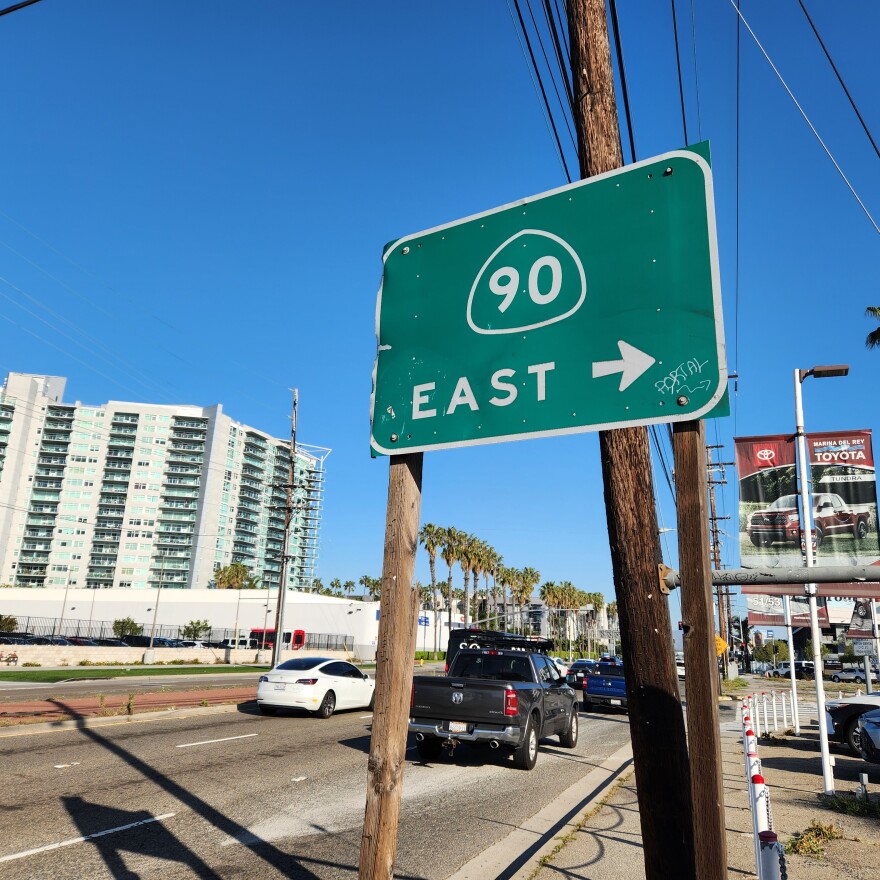Truth matters. Community matters. Your support makes both possible. LAist is one of the few places where news remains independent and free from political and corporate influence. Stand up for truth and for LAist. Make your year-end tax-deductible gift now.
Why is there a SoCal freeway with a 40-mile gap?

Southern California has more than a few uncompleted freeways. But have you ever noticed the one that has a 40-mile gap?
We’re talking about the 90 Freeway and transportation officials’ grand plan to connect Marina del Rey to Yorba Linda in Orange County.
It’s one of the region’s timeless examples of what happens when residents get angry about transportation, and how a multi-million-dollar project became a bit of a dumpster fire.
A brief history of the freeway
Today, Route 90 is split in two. There’s a few freeway miles in Marina del Rey that primarily lets drivers connect to the 405 Freeway. Then there’s a few miles way to the east that start as street-level Imperial Highway. But further into Yorba Linda, it quickly turns back into what resembles a freeway that ends a few miles away at the 91 interchange.
It’s one of those things that make you scratch your head and wonder, “Who thought this was a good idea?”
You could say it works for each section’s current purpose, but they’re slices of what could have been. The freeway master plan from the 1950s called for a route that would have given inland Orange County a straight shot to Pacific Coast Highway.
Parts of it have gone by different names over the years: The Slauson Freeway, the Richard M. Nixon Freeway and the current Marina Freeway on the Westside. At one point, the whole freeway was named after Nixon because he was born in Yorba Linda, but officials removed it in 1976 after the Watergate scandal.
It’s unclear whether Caltrans officially ever acquired the entire route, but some of their sections were relinquished back to their respective cities over the decades, which removed the Route 90 designation. That’s why it’s so split apart on maps. (Fun fact: The Yorba Linda City Council opted to bring the name back for its portion as the Richard M. Nixon Parkway. And yes, that means they don’t officially call it a freeway anymore.)
The master plan got mixed reviews depending on who you ask. In the beginning, there was excitement for new areas to get high-speed access — the 90 was even called “one of the most vital elements in the freeway system.” But that love quickly soured as the paths were drawn.
Problems with the path
The project was plagued by an alleged bribe.
In 1965, West L.A. Assemblymember Lester McMillan was indicted by an L.A. County grand jury on a charge of soliciting a $10,000 bribe. The charge stemmed from a secret recording during a discussion between the lawmaker and Culver City business leaders about introducing legislation to reroute the freeway.
McMillan admitted to taking action against a proposed route that would have gone through a business district in the neighborhood because “people were up in arms about it,” but money never changed hands. The charges were eventually thrown out after his lawyers argued it would have been a fee for his expenses.

Meanwhile homeowners who would have been displaced in other areas if the freeway was fully built also got angry and protested votes on the path. Residents argued that there was a serious lack of oversight in the state’s freeway planning process.
As opposition grew, county Supervisor Kenneth Hahn asked then-Gov. Ronald Reagan in 1967 to intervene in the “Slauson Freeway fight” and cancel a key public hearing that was slated to happen with his administration shortly after he took office.
However, the meeting was held, and added to concerns that the freeway was being developed too fast and without much thought. Residents and local officials grew concerned that a commission, which was in charge of reviewing freeway recommendations from the state division of highways, was improperly making decisions. Opponents claimed the division used “questionable practices” and gave inaccurate traffic predictions. (Early figures estimated at least 170,000 drivers a day by 1970.)

As residents worried L.A. would become a patchwork of freeways, demands grew for an overall state transportation study that included rapid transit planning.
At the end of 1967, city leaders banded together to come up with better ideas. While the state highway department still had jurisdiction, the hope was that they could try to ensure a route that didn’t “wipe out the middle of a city,” said La Mirada Mayor Edward Le Clair.
But disdain for the freeway solidified in the early '70s, in part because there wasn’t enough money to build it, and other freeways with similar routes were already happening, such as the 105 Freeway. The L.A. County Board of Supervisors, which had previously backed the Slauson Freeway, moved to kill portions of it in 1973, and two years later, so did the state.
The 90 Freeway plans died that decade in part because money dried up, inflation was high and there was a major gas shortage. Groups hope to reuse some of the space. Plans have proposed in recent years to turn the Westside’s Marina Freeway into affordable housing and green space.











